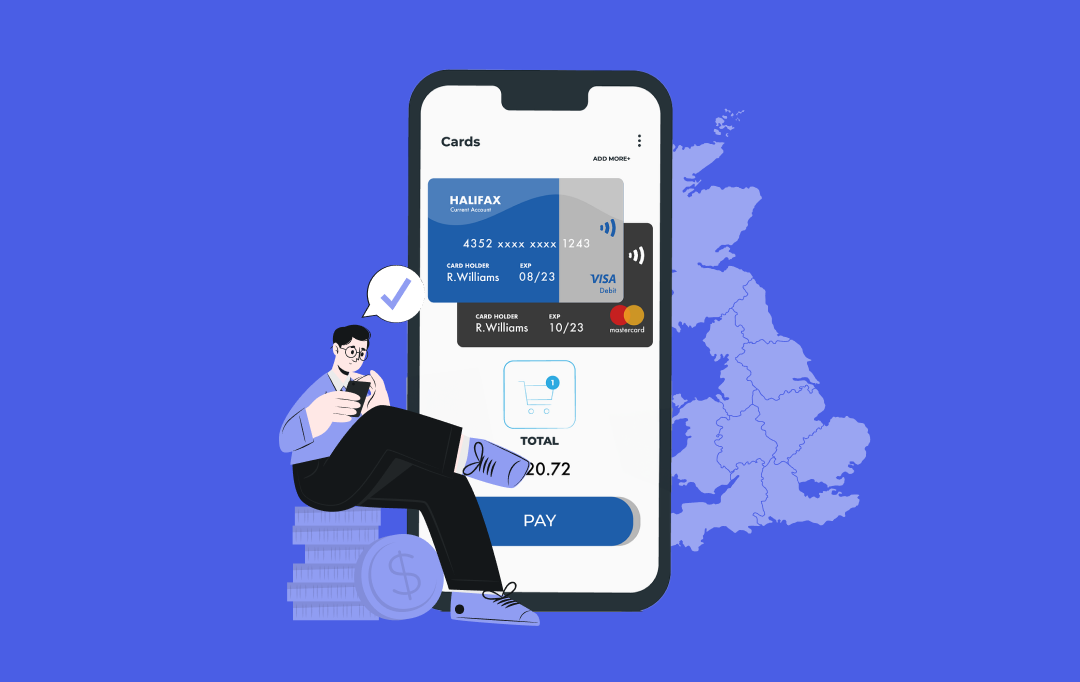- What is Biometrics in Digital Banking?
- Benefits of Biometrics in Banking
- Improved Security
- Enhanced Accessibility
- More Prominent Operating Efficiency
- Reduce Scam
- What Types of Biometric Authentication Methods are Used in Digital Banking?
- How Does Biometrics in Banking Work?
- Biometric Authentication in Banking Example for the Financial Sector
- Fingerprint Scanning
- Face Verification
- Voice Recognition
- Iris Scanning
- Signature Recognition
- Finger Geometry
- Gait Recognition
- Current Trends in Biometric Authentication
- Use Cases Of Biometrics In Banking
- Customer Onboarding
- Customer Re-Authentication
- ATM’s
- Mobile Banking
- Are There Any Security Risks Involved in Using Biometrics in Banking?
- How to Enhance the Security of Biometric Technology?
- How Appinventiv can help you leverage biometric technology for your mobile banking or FinTech app
- FAQ’s
Financial institutions require a secure authentication system such as biometrics in digital banking to protect sensitive information and enhance customer experience. Knowledge-based authentication methods, such as passwords, PINs, or OTPs, are easily forgotten, stolen, or compromised. Microsoft revealed 44 million user accounts were exposed to account takeover due to weak passwords. Google revealed most users reuse passwords on multiple sites, leaving them vulnerable.
That’s why biometric verification for bank accounts is becoming increasingly integral to financial industry security platforms. Biometrics provides robust and reliable authentication for ATM, brick-and-mortar, and online transactions. It helps boost customer trust in banks and increase banking institutions’ brand reputation.
A survey published by Visa showed that 65% of consumers feel more comfortable using biometrics in banking for safeguarding their payment details–ruling out traditional security methods entirely at this point. The necessity for strict identity verification due to the accelerating adoption of transactional technologies has made biometric use in banking crucial for financial institutions.
What is Biometrics in Digital Banking?
Biometrics authentication is rapidly becoming a staple in the banking industry by providing more secure identity verification processes. This technology uses physical characteristics like facial recognition, fingerprint scan, voice recognition, and retina recognition to authenticate the user.
The market for biometrics authentication currently holds much of its share in banking, such as mobile banking, online banking, ATMs, and even in-branch banking. Juniper Research has found that mobile biometrics will process approximately $2 trillion of in-store and remote payments annually by the end of 2023 — 17x more than the $124 billion expected by 2018. In addition to advanced transactional technologies addressing endemic fraud issues, traditional security methods no longer suffice — hence, biometric technology in banking systems is crucial for safeguarding against data breaches and other threats.
Benefits of Biometrics in Banking
Biometric verification for bank accounts is increasingly becoming a fundamental part of the banking and FinTech industry, as it offers an increased level of security and convenience compared to traditional methods. Here are some key benefits to consider:

Improved Security
Biometric authentication in mobile banking applications (read about mobile banking app cost here) provides a secure, reliable way to bank on the go. This method is a welcome alternative to usernames and PINs as it offers stronger safeguards against fraud or erroneous access attempts. Moreover, biometric traits are impossible to reproduce digitally, creating an environment of heightened security for users’ financial accounts.
Enhanced Accessibility
Biometric authentication in mobile banking offers customers a more convenient solution than traditional passwords and physical security keys. Instead, customers can utilize their fingerprints, facial recognition, or voices to quickly and smoothly access their accounts. This removes the necessity of remembering complex passwords or the risks of losing physical security keys.
More Prominent Operating Efficiency
Biometric use in banking methods can offer a great advantage to customers when compared to traditional banking processes in terms of time saved. Additionally, banks that employ these forms of identification can reduce the need for manual reviews and investigations, subsequently increasing their operational efficiency.
Reduce Scam
Biometric technology in banking offers powerful protection against fraudulent activities like identity theft or account takeover. It works by detecting abnormalities in user behavior or biometric traits, which may indicate malicious intent. On notification of such incidences, banks can take swift action to mitigate any potential financial damage.
What Types of Biometric Authentication Methods are Used in Digital Banking?
You must collect unique biometrics data to incorporate biometric security in your organization. Types of biometric banking falls into three main categories: morphological (structures of the body), biological (genetic and molecular characteristics), and behavioral (habits). Morphological biometrics commonly include fingerprint or face shape recognition, while biological can range from DNA to blood. For behavioral biometric technology in banking, voice recognition is an increasingly popular method for financial institutions today. Note that bank verifications and identifications typically use morphological traits such as fingerprints or facial scanning. Additionally, finger/palm vein readers and iris scanners are often used by banks as well.
How Does Biometrics in Banking Work?
Modern biometric security systems enable digital identity authentication and authorization. They are powered with special software that processes collected data and utilizes dedicated scanners, which can be small or large depending on the data type required.
To start the process, a scanner captures biometric information, converts it into a digital format, and matches it to an existing database. In the case of matching samples, the user is granted access; if not, access is denied, or the appropriate message is displayed for a system operator. This makes passwords redundant by introducing certain biometric security measures instead.
In summary, the successful implementation of biometric systems includes three steps: enrollment (collecting identifying data), storage (protection from unauthorized users), and comparison (verifying customer’s identity). Biometrics have considerably improved safety in banking operations while making them much more convenient for customers.
Biometric Authentication in Banking Example for the Financial Sector
![]()
Organizations or individuals looking to implement biometric security systems must first determine which data elements are most crucial for their plans. Since not all biometric identifiers are equally easy to capture and process, there are a few key considerations when making this decision:
Fingerprint Scanning
Banking institutions such as Bank of America have incorporated this type of authentication into their Android and iOS banking applications. Consumers are already accustomed to unlocking their smartphones with fingerprints and making purchases online with biometric fingerprint payment system, so it’s only natural that they would feel comfortable using similar technology to make financial transactions within the banking sector.
Fingerprint scanners have been gaining traction in places like Poland, where 2000 ATMs at bank branches and supermarkets use finger vein recognition technology, and multiple Japanese banks for access control of safety deposit boxes inside branches. In the near future, more companies will likely be using fingerprint authentication systems on mobile devices and physical locations.
Face Verification
The financial sector is increasingly seeking facial recognition technology in its banking systems. ‘Selfie banking,’ which has been available since 2016, allows customers to onboard quickly and easily by simply taking a selfie. It compares with the picture on their government-issued ID document; customers don’t have to visit a bank’s physical branch. AI-enabled technologies in the banking industry backed up by reliable biometrics provide both convenience and security.
Additionally, this technology can be used in online transactions, such as with Apple Pay, Selfie Pay, and AliPay, which offer facial biometric authentication in online banking for added protection. USAA was the first major bank to adopt facial biometrics back in 2015. Facial recognition software continues to grow in popularity within the financial sector across multiple platforms.
Voice Recognition
Voice recognition is a rapidly growing technology with many potential benefits for customers. Using AI and machine learning, speech modulation, accent, tones, and frequency are measured to create a voice print-a reference template used for customer identification. These voiceprints allow customers to replace passwords or PINs for increased security.
Research suggests that $8 billion in digital voice assistants will be implemented globally by 2023, with over $80 billion in spending on voice commerce opportunities. Voice recognition was first introduced in banking as early as 2014 and is now quickly gaining popularity within sectors spanning consumer electronics, medical diagnostics, and finance services.
Voice biometrics are fundamentally different from passwords in terms of security. Unlike the plain text passwords, voiceprints are stored in an encrypted format, making them hard to decode even if someone were to access them. Furthermore, every time a fraudster engages with the voice-activated IVR system, their voice is recorded – enabling accurate detection and preventing further unauthorized attempts.
Iris Scanning
Biometric iris scanning is a prominent identity verification method used to identify individuals based on the distinctive patterns in their irises. It is recognized for its reliability, accuracy, and absolute security. Traditional authentication systems that rely on passwords, pins, and other knowledge-based methods can be vulnerable to hacking; however, iris scanning offers much greater protection of confidential information.
Earlier adopted primarily in airports for security screening purposes, iris scanning is now becoming more widespread with numerous programs set up at ATMs within the financial sector, such as Bank of America and the National Bank of Qatar. Furthermore, some countries even use technology for convenient border crossings without passwords.
Signature Recognition
The most common form of signature recognition involves static (offline) or dynamic (online) processing. Static recognition involves capturing a handwritten signature as a graphic image and comparing it to an existing copy. Dynamic processing collects data regarding time, rhythm, pressure, and other details when a touchscreen device provides a signature.
Finger Geometry
Biometric scanning with the latest finger geometry systems provides maximum accuracy and captures detailed information such as shape, surface, length, width, thickness, and distance between fingers. Cutting-edge three-dimensional imaging is used to capture every detail.
Gait Recognition
Gait is a unique locomotion pattern for every individual and is characterized by body size, speed of movement, stride length and width, angles, and other observed features. Gait-based authentication has applications in biometric identification systems; sports science; medical diagnosis and research, and many other fields. High-accuracy gait recognition cameras analyze these features to provide reliable verification results.
Current Trends in Biometric Authentication
As technology advances, businesses are adopting innovative biometric solutions to improve authentication and protect sensitive data. Let’s check out some of its key trends:
- Passwordless Authentication: Biometrics is replacing traditional passwords, enabling secure logins through facial recognition, fingerprints, or voice authentication, enhancing both security and convenience.
- AI-Powered Biometric Authentication: Artificial intelligence enhances biometric security by detecting fraud attempts, learning user patterns, and adapting to changes in appearance or behavior over time.
- Multimodal Biometrics: Using multiple biometric methods (fingerprint, facial recognition, and voice) together increases authentication accuracy and reduces the chances of false positives or spoofing.
- Biometric Authentication for Payments: More banks and payment providers are integrating fingerprint and facial recognition for secure transactions, eliminating the need for passwords and reducing fraud risks.
Behavioral Biometrics: Tracking user behavior, such as typing speed, touchscreen gestures, or mouse movements, provides continuous authentication, adding an extra security layer beyond traditional biometrics.
Use Cases Of Biometrics In Banking
Biometrics is becoming more prevalent in banking to authenticate customers and secure their assets. Instead of passwords, tokens, signatures, and PINs in-branch services, it can be used via mobile banking and ATMs. Banks are well-served by implementing biometric authentication in banking measures; it helps enhance customer service while providing higher security. Here are the applications of biometrics in banking.
Customer Onboarding
Financial organizations can streamline their customer onboarding process with biometric technologies. The Know Your Customer (KYC) verification that is inherently part of the onboarding process is often left for customers to perform in person, requiring them to visit a branch and present documents – this may take days or weeks. Technological advances pave the way for systems to offer streamlined services to customers; they expect convenience at all times. Biometrics in banking examples, such as facial recognition, offer reliability and security while allowing banking organizations to cut down on time spent onboarding customers.
Customer Re-Authentication
Biometric authentication strengthens security by verifying user identity during critical banking actions such as logging in from a new device, authorizing high-value transactions, or resetting credentials. Using fingerprint scans, facial recognition, or voice authentication, banks can enhance fraud prevention while providing a seamless and password-free re-authentication experience. This reduces the risk of unauthorized access and improves user convenience, eliminating the need for complex passwords or OTPs.
ATM’s
Biometrics in banking ATMs has gained traction in multiple developed countries, with the two most popular authentication methods being PINs assisted by biometric traits like facials and fingerprints. This is due to their practicality when implemented in ATM systems – they provide convenience and accuracy and are space-efficient. Therefore, it is no surprise that more banks embrace biometrics in their ATMs.
Mobile Banking
The use of mobile banking platforms is increasingly on the rise. Research shows that 79% of smartphone owners have used their devices for online purchases in the past year, with 70% of millennials utilizing mobile banking specifically. Yet, there is still a lack of security regarding these platforms due to an increasing number of fraud cases since 2015. To combat this, facial biometric authentication in online banking can be employed to access banking services such as KYC monitoring and transaction identification. Banks must ensure that customer data is kept secure by employing advanced technologies from reliable sources, making biometric authentication in banking an effective protective measure.
Are There Any Security Risks Involved in Using Biometrics in Banking?
Biometrics in banking systems offer higher security than other authentication systems; however, susceptibilities remain. Attackers are good at finding ways to trick biometric scanning tools, such as creating 3D models from photos of people off of social media and being able to use deep fakes. Additionally, the software that goes into biometric systems generates and stores confidential user data, so extra measures such as using cloud computing for banking, should be taken to protect it. For example, in 2015, when US government computers were hacked, the fingerprints of 5.6 million employees were stolen. As a result, integrating biometric technologies with other forms of authentication is an ideal approach.
How to Enhance the Security of Biometric Technology?
Regarding biometric security systems, vulnerability is an issue that needs to be addressed. Luckily, there are reliable approaches you can take to protect against breaches and fraud. These include requiring multiple means of authentication, using cloud-based storage, and hiring an experienced AI software development services company. Combining iris scans with fingerprints is often a good option for ultimate security. Additionally, partnering with a provider who stores data in the cloud and encrypts it will prevent unauthorized access. Finally, bringing on professionals specializing in this type of project can greatly reduce the chances of mistakes.
How Appinventiv can help you leverage biometric technology for your mobile banking or FinTech app
Biometrics is a trending technology that could change how banks and financial services companies operate in the coming years, offering a path to not just enhanced security but also promoting sustainable banking practices by streamlining processes. If you’re looking for more opportunities to help your users verify their identity quickly and securely, biometrics in digital banking can be an effective solution. Appinventiv has worked with a multitude of FinTech companies and leading global banks delivering top notch fintech app development services to our clients.
Implementing such a system takes significant technical expertise. At Appinventiv, we provide professional customized solutions to help businesses integrate biometric technologies into their business models and benefit from them the most. Reach out to us today, and let’s explore what we can do together!
FAQ’s
Q. What is Biometrics in Digital Banking?
A. Biometrics is an integral element of digital banking. This technology uses physical and behavioral characteristics, such as fingerprints or facial recognition, to identify customers and grant them access to their accounts through online channels. It provides an added layer of security while delivering a positive user experience. Biometric authentication in banking helps curtail fraud and improve overall banking safety.
Q. How secure is biometric authentication in digital banking?
A. Biometric authentication provides improved security compared to the traditional password-based approach in the digital banking sector. Despite this enhanced protection, biometric data might still be vulnerable to theft or manipulation, as successful attacks have occurred.
Q. What is the cost of biometric banking?
A. Biometric technology adoption in banking may involve an initial investment in hardware, software, and infrastructure. Nonetheless, depending on factors such as the size of the institution, the type of biometric technology used and deployment scope, long-term cost savings can be realized due to fraud reduction, operational efficiency improvement and elevated customer experience. Therefore, the long-term benefits of biometric technology adjustments often outweigh the biometric authentication in banking cost.
Q. What are the advantages of using biometrics in digital banking?
A. In digital banking, there are various advantages of biometrics in banking to users, such as improved security, convenient and speedy access to accounts, decreased risk of identity theft and fraud, plus an enhanced customer experience. Additionally, biometrics in digital banking eliminates the need for clients to memorize complex passwords, making the login process much simpler and more user-friendly.


- In just 2 mins you will get a response
- Your idea is 100% protected by our Non Disclosure Agreement.

How Appinventiv Solved Scalability Challenges for FinTech Platforms with 10M+ Users
Scalability is a crucial element in the FinTech sector as it is experiencing phenomenal growth due to the global population's need for streamlined, on-demand security and instant financial services. With the rise in user bases and transaction volume, FinTech applications must manage the growing demand without compromising performance or security, while also providing a pleasant…

How Much Does it Cost to Build a Personal Finance App like Pocketsmith?
Imagine an app that knows when your rent is due, reminds you of upcoming bills, forecasts your savings 12 months ahead, and tells you if that third coffee this week is wrecking your budget. That’s the kind of experience apps like PocketSmith deliver, and it’s exactly why personal finance apps are becoming a must-have for…

How Much Does it Cost to Build a Mobile Banking App Like Halifax in the UK?
The way people bank has changed dramatically. Gone are the days of waiting in long queues or rushing to a branch before closing hours. Today, mobile banking apps like Halifax have redefined convenience, allowing users to check balances, transfer funds, pay bills, and even apply for loans from their smartphones, anytime and anywhere. This shift…


















